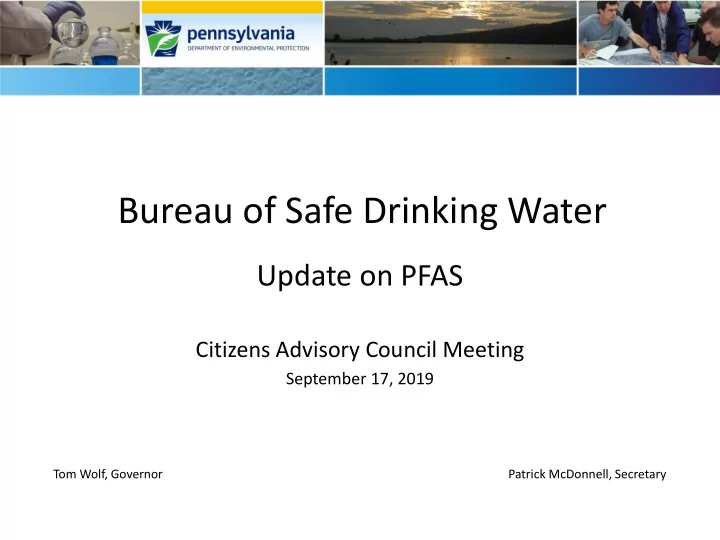

Bureau of Safe Drinking Water Update on PFAS Citizens Advisory Council Meeting September 17, 2019 Tom Wolf, Governor Patrick McDonnell, Secretary
Federal Actions to Address PFAS • EPA issued a Provisional Health Advisory Level (HAL) in 2009 for PFOS and PFOA of 200 ppt and 400 ppt, respectively. • Six PFAS were included in EPA’s Third Unregulated Contaminant Monitoring Rule (UCMR 3). • Monitoring was conducted between 2013 – 2015 for PFOS, PFOA, PFNA, PFBS, PFHxS & PFHpA • 175 public water systems in PA sampled, 6 had detects for PFAS • In 2016, EPA set a Combined Lifetime HAL for PFOS and PFOA of 70 ppt. • EPA issued a PFAS Action Plan in February of 2019, but has not set any specific deadlines for promulgating enforceable standards (MCLs) for PFAS in drinking water. Because of this, several states including PA are taking action at the state level.
State Actions to Address PFAS • Executive Order from Governor Wolf (Sept. 19, 2018): Established a PFAS Action Team to develop a comprehensive response to identify and eliminate sources of contamination, ensure drinking water is safe, manage environmental contamination, review gaps in data and oversight authority, and recommend actions to address those gaps. • DEP’s state laboratory has installed equipment, trained staff, and is working towards accreditation to test for PFAS in water. • DEP’s Environmental Cleanup Program has been and will continue to address PFAS contamination sites, and is moving forward with proposed amendments to Chapter 250 to establish remediation standards for PFOS, PFOA and PFBS.
BSDW Actions to Address PFAS • BSDW is implementing a statewide PFAS Sampling Plan to identify impacted public water systems and generate statewide occurrence data. • BSDW is moving forward with a contract for toxicology services and will coordinate with the Department of Health to review/evaluate health effects data and studies, and propose toxicity values and draft MCLs for select PFAS. • BSDW has and will continue to ensure follow-up and corrective actions are taken at public water systems with PFOS/PFOA levels above EPA’s HAL of 70 ppt.
PFAS Sampling Plan Phase 1 of the Sampling Plan is intended to prioritize sites for PFAS sampling and generate statewide occurrence data. Several factors were considered in developing the plan, including: • Location of potential sources of PFAS contamination (PSOC) • Public water supply (PWS) sources located within ½ mile of PSOCs • Selection of PWS sources to serve as a control group
PSOCs The GIS data layer of PSOCs includes the following industries and land uses: • Military bases • Fire training schools/sites • Airports • Landfills • Manufacturing facilities (apparel, chemicals, electronics, fabricated metal, paper products, textiles and leather, upholstered furniture) • HSCA sites and known PFAS-contamination sites
Example of PSOC Map Within Plan
PFAS Sampling Plan Phase 1 of the PFAS Sampling Plan: • Sampling began in June and will conclude in ~ a year • Sampling will include approximately 360 PWS samples from community and nontransient noncommunity water systems located within ½ mile of PSOCs • Sampling will also include 40 sites from a control group of PWSs to determine baseline • Note: The list may be updated as new information becomes available regarding potential sources of contamination
Areas of State Included in Sampling Plan
Authority to Require Actions DEP’s authority under PA SDWA and Chapter 109 regulations to require actions to address unregulated contaminants: • § 109.4 General requirements • § 109.203 Unregulated contaminants • § 109.302 Special monitoring requirements • § 109.409 Tier 2 public notification requirements • § 109.701(a)(3) One-hour reporting requirements DEP’s long -standing guidance and protocols for addressing unregulated contaminants: • Health Effects and Risk Management Guidance (DEP #383- 0400-104)
Follow-up and Corrective Actions Follow-up and corrective actions for an exceedance of a HAL may include: • One-hour reporting of sample results to DEP • Collection of confirmation samples • Issuance of Tier 2 PN • Quarterly monitoring at the entry point • If levels continue to exceed the HAL, additional actions may be needed including taking sources off-line, blending sources, installing treatment, etc.
Ongoing Challenges and Concerns • Federal vs. state-led efforts to address PFAS or set MCLs – inconsistency and lack of public confidence • For state-led efforts, lack of expertise and resources • Lack of available analytical methods (for additional matrices, additional PFAS); lack of national certification program • Limited lab capacity and high analytical costs • Lack of national design, construction and efficacy standards for PFAS treatment – states are on their own • Lack of data/studies regarding proper disposal methods • Due to long-term, widespread and ongoing use in commerce, there is no easy solution
Lisa Daniels, Director Bureau of Safe Drinking Water 717-787-9633 ldaniels@pa.gov DEP’s PFAS Webpage https://www.dep.pa.gov/Citizens/My- Water/drinking_water/Perfluorinated%20C hemicals%20%e2%80%93PFOA%20and%2 0PFOS%20%e2%80%93%20in%20Pennsylv ania/Pages/default.aspx
Recommend
More recommend